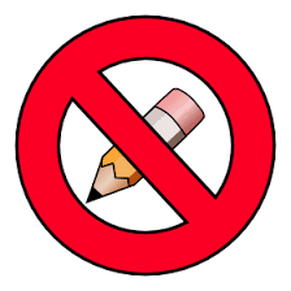 I love returning to school in September. I get giddy with excitement purchasing school supplies and can't wait to meet my new students. This year my two kids have started Grades 6 and 8. They also share my love of picking out colourful pencils, pens, binders, and such, but since we didn't know what was required for high school I told my son we would purchase his supplies at the end of the first week. Last weekend, I took the necessary time to review my son's course outlines. Generally they were as I expected but it was a comment from my son that caused me pause. He told me that he needed more pencils and a bigger eraser for Math. He said that all his Math work had to be done in pencil and the erasers at the end of pencil weren't going to be big enough to erase mistakes. Herein, is where my mind started buzzing with questions. This long-standing tradition of using only pencil in Mathematics so students can erase their errors doesn't make any sense to me! We don't insist on using only pencil in any other subjects, so why Math? In writing, when students review and revise their work, they simply write on top or under what they have written, cross one word out and add another and add indentation marks to show where they have added. This makes it possible for teachers to see the trajectory of learning. Likewise, when children read to us and they make a mistake, we don't halt them and say "stop, that's incorrect"; instead we give them time to see if they catch their mistake and self-correct and then we discuss the error and strategies to help the student. The practice of writing in pencil so that we can erase mistakes in Math runs contradictory to all the current research we know about developing growth mindsets, honouring process over product, and capitalizing on opportunities to move our students' learning forward. Jo Boaler writes Studies of successful and unsuccessful business people show something surprising: what separates the more successful people from the less successful people is not the number or successes but the number of mistakes they make, with the more successful people making more mistakes (Mathematical Mindsets, 2016, p.g. 15) If mistakes are a necessary part of our learning process, then why are Math teachers asking children to erase them? I believe mistakes should be seen positively, as they show what the child currently understands and any misconceptions are opportunities for learning to occur. Furthermore, we know from both research and experience that when we build classroom communities that are safe to take risks and use errors for instruction, we have the potential to increase our students' understanding (Bray, 2013). Why would we give up this opportunity by encouraging erasing? I have wrestled with this idea before. Two years ago I sat frustrated trying to figure out my son's understanding about adding fractions with different denominators.I knew he had some misconceptions but I couldn't make sense of his thought process because the work he brought home from school had been fully erased. He had shown his teacher his work and was told to erase it and re-do it. I then asked his teacher to please refrain from having my son erase and explained my rationale. Here we are two years later with more knowledge about the importance of mistakes as part of learning and I am unsure if we are further ahead. I would like to be able to tell you that both my children are using only pen in their Math classes but that wouldn't be the truth. They don't want to stand out against their peers or make their teachers unhappy so they continue to use pencil... but they no longer erase (at least that I can see). As I move forward supporting both teachers and students in Math classes this year, I will be bringing with me a beautiful tin of colourful pens, with all sorts of interesting designs, including some that are smelly! We will use these to record our Mathematical thinking and understanding and there will be NO ERASING! All thoughts will be valued and mistakes will be seen positively, as part of our learning and growing process! I am interested to hear others thoughts on this topic and the role pencils and erasers play in your Mathematics classes. Please feel free to add a comment. Boaler, J. (2016). Mathematical mindsets: Unleashing students' potential through creative math, inspiring messages, and innovative teaching. Bray, Wendy S. 2013. "How to Leverage the Potential of Mathematical Errors." Teaching Children Mathematics 19 (7): 424-431.
1 Comment
|
About Me
I am a Numeracy Helping Teacher with the Surrey Schools District. Each day I am thankful for being able to work with amazing students and teachers in an area I am passionate about ~ Mathematics! Subscribe:Click the RSS feed button
Archives
October 2018
Categories
All
|

 RSS Feed
RSS Feed
